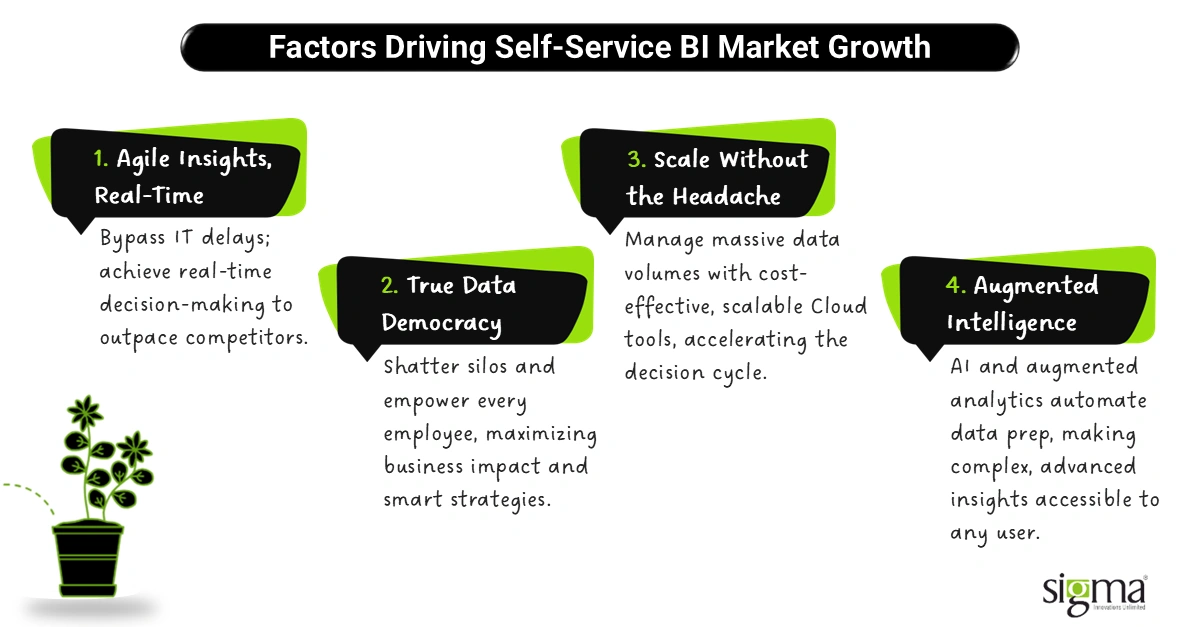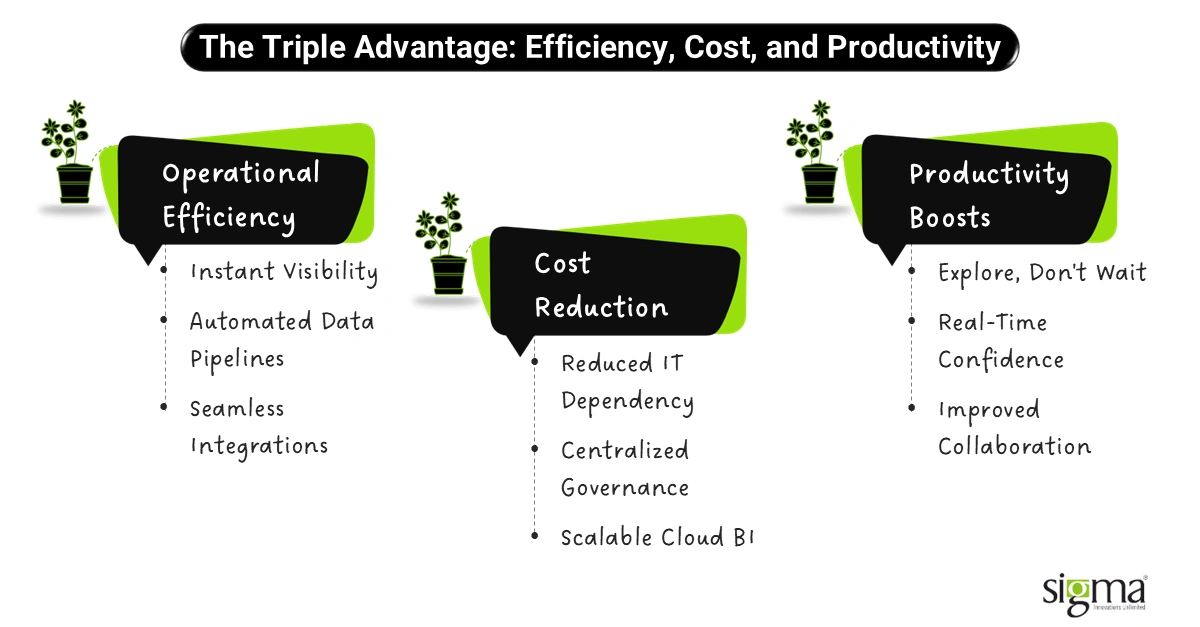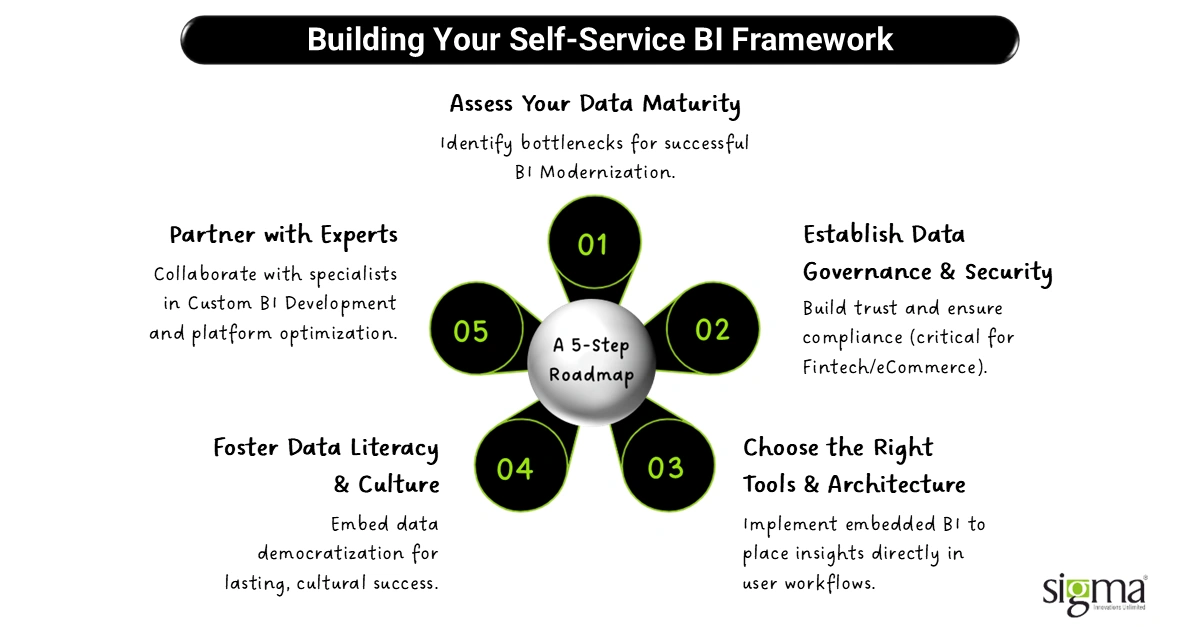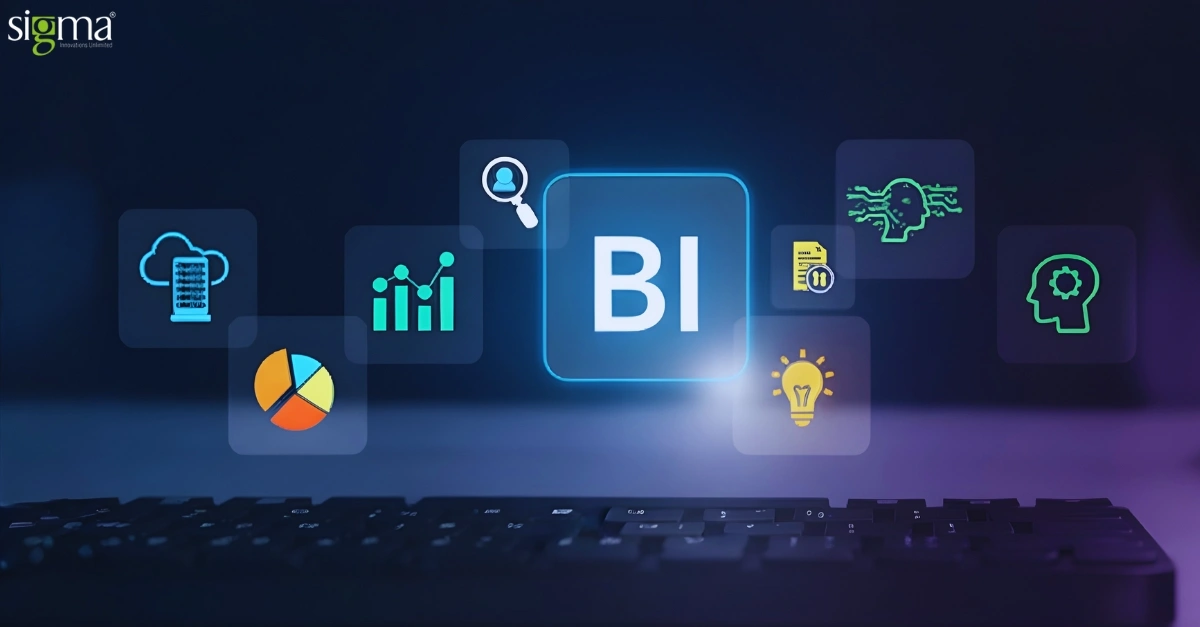Self-Service BI: The Key to Democratizing BI and Analytics Across Organizations
Key Takeaways:
- Traditional BI is like driving with a backseat navigator. You get directions, but only after the turn has passed. Self-Service BI puts you behind the wheel of your data journey.
- Centralized reporting creates bottlenecks. Self-Service BI clears the traffic by letting every team access, explore, and act on insights without waiting in line.
- Empowering data users is like giving everyone a map and a compass. With the right tools and governance, businesses move faster, smarter, and further together.
Mid-market leaders in eCommerce, Fintech, and engineering are generating unprecedented data volumes, but the simple truth is they’re starving for swift, usable intelligence. Every department, from marketing and sales to finance and operations, collects mountains of information daily, yet most of it sits untouched because teams depend on a small, centralized BI unit to make sense of it. This traditional setup slows everything down. Reports get delayed, decision-making becomes reactive, and by the time insights reach the right people, the opportunity has already passed.
That’s why the business world is moving toward Self-Service BI, a game-changer that puts the power of analytics directly into the hands of decision-makers. Instead of waiting weeks for IT or analysts, business users can explore dashboards, uncover trends, and act instantly. This shift marks the era of data democratization, where information flows freely across teams, breaking silos and fueling faster innovation.
The truth is, Self-Service BI isn’t just another technology trend; it’s a strategic imperative. It helps companies boost operational efficiency, cut reporting costs, and enhance productivity by turning raw data into real-time, actionable insights. For growing enterprises, that’s not optional anymore, it’s survival.
In this article, we’ll explore why and how organizations can make this shift and how Sigma Infosolutions, a trusted BI & Analytics Development Services provider in the USA, helps enterprises transform data into decisions with technologies like Power BI and Tableau.
Centralized BI Is a Bottleneck to Growth (The Problem)
If data is the new oil, most mid-market enterprises are still digging with a teaspoon!
Traditional centralized BI models may have worked a decade ago, but in today’s data-driven world, they’re slowing down growth rather than fueling it. Leaders in Fintech, eCommerce, and product engineering often share the same frustrations of too many requests, too few insights, and too much waiting.
Here’s what that looks like inside most organizations:
- Slow Decision-Making: Every report or dashboard request passes through IT or a dedicated BI team. By the time executives get their answers, the opportunity window has already closed.
- Operational Inefficiency: Analysts act as gatekeepers instead of enablers, creating queues of pending data requests. This not only stalls projects but also lowers team morale.
- Cost Escalation: Maintaining multiple reporting tools and redundant data processes increases overhead and complexity.
- Data Disempowerment: Business users, who understand the problems best, can’t access or interpret their own data. The result? Missed insights and poor data literacy across departments.
Example: Imagine a fintech lender waiting two weeks for portfolio risk metrics. In a fast-moving credit market, that delay can translate into millions lost in missed lending opportunities.
The hard truth is that centralized BI no longer fits the agility demands of modern digital enterprises. In a world where data changes by the second, waiting for insights is like driving with the rear-view mirror, you’ll always be one step behind.
The Rise of Self-Service BI (A Paradigm Shift)
Enter Self-Service BI, the antidote to bottlenecked analytics. It’s a modern approach that empowers every user, from analysts to marketing managers, to explore data, create dashboards, and make data-driven decisions without waiting on IT.
At its core, Self-Service BI is about giving people tools like Power BI and Tableau to independently visualize and analyze data, which means no code is required. That freedom unleashes creativity, speeds up insight discovery, and fuels a data-driven culture.
“By 2032, the global Self-Service BI market is set to be a $26.54 billion industry, driven by an aggressive 18.7% CAGR as organizations rush to empower their teams with data.”
Why the Market Is Moving This Way
The explosive growth of Self-Service BI is driven by organizations prioritizing speed, autonomy, and efficiency in a volatile market:

- Speed Over Stagnation: Forget waiting for reports. Self-Service BI provides real-time data access, empowering teams to bypass IT bottlenecks and achieve the agile decision-making needed to outpace the competition.
- Data for Everyone: This is true data democracy. By shattering silos, you give every employee the power to analyze data independently, fostering smarter strategies and maximizing business impact.
- Scale Without the Headache: Handle massive data growth with cost-effective, scalable tools. By distributing analytical power, you eliminate a major dependency on central IT, accelerating the entire decision-making process.
- Augmented Insights: The synergy of Cloud and AI simplifies everything. Automated data preparation and augmented analytics make advanced insights accessible to any user, not just data scientists.
Self-Service BI is the critical step to boost operational efficiency, reduce costs, and ensure your organization’s future productivity.
Snapshot of Benefits
- Faster time to insights: No more waiting in data queues.
- Reduced IT dependency: Business users take charge of their own dashboards.
- Improved data-driven culture: Decisions are based on facts, not guesses.
- Cost savings through efficiency: Fewer redundant tools, more unified visibility.
“Data democratization isn’t about giving everyone data, it’s about giving everyone the confidence to use it effectively.”
This new wave of Self-Service Analytics is not just improving productivity, it’s redefining enterprise agility. And with the right BI & Analytics Development Services, organizations can finally bridge the gap between data and action.
Also Read: Emerging trend of self-service analytics and the best tools available to you
How Self-Service BI Drives Efficiency, Cost Reduction, and Productivity
Every growing organization eventually hits the same wall: too much data, too little action. While traditional BI teams drown in report requests, forward-thinking companies are flipping the script with Self-Service BI. This modern approach, powered by Power BI, Tableau, and embedded analytics solutions, transforms data into a living, breathing asset that drives results in real time.
Let’s break down exactly how Self-Service Analytics creates measurable business impact across three key areas: operational efficiency, cost savings, and productivity.

Operational Efficiency
Your business runs in real-time, but your reports don’t. That lag is a direct drain on profit and productivity. Self-Service BI delivers operational agility by empowering teams to find answers the moment they need them.
- Real-time dashboards give managers instant visibility into KPIs like sales, inventory, or risk exposure. Instead of asking IT for updates, they can track trends live and take action within minutes.
- Automated data pipelines streamline reporting by pulling from multiple systems (CRM, ERP, finance) into one unified view. This eliminates hours of manual data cleanup every week.
- Seamless integrations with Power BI, Tableau, and embedded BI tools drastically shorten the insight-to-action cycle.
This is where BI modernization pays off. By aligning people, processes, and platforms, organizations can break free from traditional reporting delays and operate with the speed their markets demand.
Cost Reduction
One of the least discussed but most powerful outcomes of Self-Service BI tools is their impact on cost optimization. Instead of ballooning data teams and complex license structures, companies can run leaner, smarter operations.
- Reduced IT dependency: Since business users can build and share dashboards themselves, there’s less need for dedicated report developers or full-time analysts.
- Centralized governance: A unified BI layer prevents tool sprawl, no more paying for three platforms to do the same job.
- Cloud BI solutions lower infrastructure and maintenance costs while enabling scalable performance across global teams.
Productivity Boosts
When people have data at their fingertips, productivity soars!
Instead of waiting on reports, employees explore their own insights faster, smarter, and more confidently.
- Empowered employees can make informed decisions in real time, whether it’s a finance director spotting a revenue leak or a marketing manager optimizing campaign ROI.
- No repetitive data requests: Self-service dashboards eliminate the endless back-and-forth between departments.
- Improved collaboration: Teams across marketing, finance, and operations align around a single source of truth, strengthening transparency and teamwork.
Our Expertise in Action
An Atlanta-based lender faced major challenges with fragmented data and legacy reporting. Sigma Infosolutions stepped in, deploying a centralized Data Warehouse using SQL Server and Azure Data Factory to consolidate all critical sales, loan, and transaction data. This solution delivered real-time insights via new Power BI reports on metrics like application flow and portfolio performance, eliminating slow, error-prone manual processes. The result? Improved efficiency, enhanced decision-making, and a future-ready platform capable of integrating AI and advanced analytics for sustained growth. See how we built an actionable BI platform!
That’s the promise of leading BI & Analytics Development Services, not just better analytics, but better business outcomes. When organizations combine custom BI development, cloud BI solutions, and BI consulting expertise under a governed framework, they move from reactive analytics to proactive decision-making.
Self-Service BI isn’t a side project, it’s a core growth enabler. By focusing on operational efficiency, cost control, and productivity, companies can unlock the full value of their data. With the right partner like Sigma Infosolutions, a trusted BI & Analytics Development Services provider in the USA, businesses can turn insight into impact and drive measurable ROI through intelligent, scalable, and democratized analytics.
Also read Emerging trend of self-service analytics and the best tools available to you
Building a Self-Service BI Framework for Your Organization
Transitioning to a Self-Service BI model isn’t just about adopting new tools, it’s about reshaping how your organization thinks about data.
To make this shift successful, you need the right foundation, structure, and cultural mindset. Here’s a clear, step-by-step guide to help you build a sustainable framework based on Sigma Infosolutions’ experience delivering BI & Analytics Development Services in the USA for fintech, eCommerce, and product-driven enterprises.

Step 1: Assess Your Data Maturity
Before diving in, take a clear-eyed look at your current BI landscape.
- Evaluate your infrastructure: Are your systems cloud-ready, or are you still dealing with on-prem silos?
- Check data quality: Identify inconsistencies, missing values, and disconnected data sources.
- Gauge user readiness: Understand whether teams have the skills or confidence to interpret and use data.
- Spot bottlenecks: Look for repetitive reporting tasks or approval loops that slow down insights.
This step sets the stage for BI modernization, helping leaders understand where to start and what to prioritize.
Step 2: Establish Data Governance & Security
Empowering users with data doesn’t mean compromising control. In regulated industries like Fintech or eCommerce, governance ensures a balance between freedom and compliance.
- Role-based access: Define who can view, edit, or publish dashboards.
- Version control: Keep a single source of truth to prevent confusion.
- Standardized metrics: Align KPIs across departments to ensure consistency.
This balance between autonomy and oversight strengthens trust in your analytics ecosystem and prevents data chaos.
Step 3: Choose the Right Tools & Architecture
Your technology stack forms the engine of your Self-Service Analytics journey.
- Select scalable tools like Power BI, Tableau, or AWS Data Lakes that integrate seamlessly with existing systems.
- Opt for a cloud-first strategy. It boosts flexibility, speeds up processing, and cuts down infrastructure costs.
- Implement embedded BI tools where users can access insights directly within their daily workflow applications.
This modern architecture supports BI cloud solutions that evolve with your business needs, not against them.
Step 4: Foster Data Literacy & Culture
Technology alone can’t drive transformation, people do.
- Train non-technical users with hands-on workshops, enabling them to explore and interpret data confidently.
- Incentivize data-driven decision-making: Recognize teams that use analytics to drive measurable business results.
- Build champions: Appoint “data ambassadors” across departments who advocate for smarter, evidence-based decisions.
By embedding data democratization into your culture, you ensure lasting success beyond dashboards and reports.
Step 5: Partner with Experts
Even the best strategy can stall without the right execution partner. Collaborate with experienced BI consulting firms like Sigma Infosolutions, which specialize in:
- Custom BI development tailored to your business model.
- Power BI Development Services and Tableau Development Services are optimized for usability and scalability.
- Designing embedded analytics solutions that empower teams with real-time intelligence.
Sigma’s BI & Analytics team has helped multiple fintech and eCommerce clients move from static reports to dynamic decision intelligence. Learn how we can build your self-service BI foundation by visiting our BI & Analytics Development Services and take the first step toward data-driven growth.
Also Read: How AI and NLP Are Revolutionizing Clinical Decision-Making
Overcoming Common Challenges in Adopting Self-Service BI
While the promise of self-service BI (SSBI) is compelling, faster insights, greater autonomy, and data-driven agility, the path to adoption often comes with real-world challenges. Understanding and proactively addressing these barriers can make the difference between a stalled initiative and a transformative success story.
Data Silos
Most organizations still operate with fragmented systems, sales data in CRM, finance data in ERP, and marketing metrics scattered across platforms. This fragmentation limits visibility and slows down decision-making.
Solution: Implement a centralized data warehouse that consolidates information from multiple sources under unified governance. This ensures consistent, reliable data that drives trust and transparency across teams.
Tool Overload
When every department uses its own reporting tool, insights become inconsistent and difficult to share.
Solution: Adopt a platform-agnostic architecture anchored by versatile tools like Power BI or Tableau. These allow integration with existing data systems, reducing redundancy and simplifying governance.
Low Data Literacy
Even with the right tools, users may struggle to interpret dashboards or query data effectively.
Solution: Build internal data champions! Power users who mentor others and foster a culture of data-driven decision-making. Pair this with continuous training and accessible documentation to empower non-technical users.
Security Concerns
Fintech and eCommerce enterprises handle sensitive data, making compliance a top priority.
Solution: Enforce role-based access control (RBAC) and align systems with leading compliance standards like SOC 2 and GDPR. This ensures data access is both secure and auditable.
Resistance to Change
Cultural inertia can undermine even the best BI strategy.
Solution: Secure executive sponsorship early on and roll out BI capabilities gradually. Demonstrating quick wins, like automated reporting or faster KPI tracking, builds confidence and accelerates adoption.
By tackling these challenges with a structured approach, organizations can pave the way for a successful self-service BI ecosystem, one where every user has the power to turn data into actionable intelligence.
Also read: BI and Analytics Powering the Competitive Edge Playbook
AI and the Next Generation of Self-Service Analytics (Future Outlook)
As organizations continue their data transformation journey, the future of self-service BI is being redefined by Artificial Intelligence (AI) and Machine Learning (ML). The next wave of analytics goes beyond descriptive dashboards, it empowers users with predictive, prescriptive, and automated intelligence.
Here’s what’s on the horizon:
- Predictive Analytics Becomes Mainstream: BI systems will evolve from showing what has happened to forecasting what will happen. By integrating ML algorithms, business users will gain foresight into trends like sales projections, customer churn, or credit risk, without needing a data science background.
- Conversational BI Through Natural Language Querying: The emergence of chat-based analytics will make data interaction as easy as asking a question. Users will simply type or speak queries like “Show last quarter’s conversion growth by region,” and get visualized insights instantly, making analytics accessible to everyone.
- Decision Automation Takes Center Stage: Future-ready platforms will not only generate insights but also recommend actions, or even automate them. Imagine BI systems that trigger marketing campaigns, adjust pricing, or flag anomalies in real time based on AI-driven decision models.
- Sigma Infosolutions’ AI + BI Vision: At Sigma, we’re advancing toward an intelligent decision ecosystem, where AI augments self-service BI with predictive modeling, anomaly detection, and adaptive dashboards. Our goal is to help businesses transition from data-informed to data-empowered, making every decision smarter, faster, and future-proof.
The fusion of AI and BI marks a new era, where insight is not just consumed but anticipated. Organizations that embrace this shift today will be the ones setting tomorrow’s competitive benchmarks.
Conclusion
Self-Service BI is no longer a luxury, it’s the cornerstone of modern, agile, data-driven enterprises. By putting analytics directly into the hands of business users, organizations can move faster, make smarter decisions, and respond dynamically to market changes. What was once a time-consuming reporting process is now an opportunity for every team to innovate through insight.
From improving decision velocity to optimizing costs and productivity, self-service BI transforms how enterprises operate and compete. With deep expertise across Power BI, Tableau, AWS Data Lakes, and custom analytics engineering, Sigma Infosolutions empowers organizations to break down data silos and create a culture of true data democracy, where insights flow freely, securely, and intelligently.
When data is accessible, insight becomes unstoppable.


